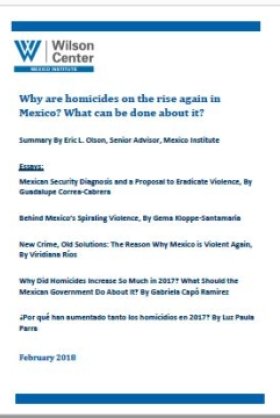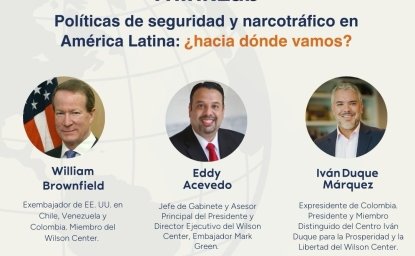Why are Homicides on the Rise Again in Mexico? What Can Be Done About It?


Summary by Eric L. Olson, Senior Advisor, Mexico Institute & Deputy Director, Latin American Program
The tragic news that Mexico set another record for homicides in 2017 is not only disheartening but puzzling. After a peak of 22,409 homicides in 2011, Mexico’s homicide rate began to trend downward and bottomed out at 15,520 in 2014. Some of the cities with the highest homicide rates, like Ciudad Juarez and Tijuana, saw significant reductions as well.
But these positive trends began to reverse themselves beginning in 2015, with major jumps in 2016, and ending 2017 with a new record of 25,339 intentional homicides. This is the highest toll since the government of Mexico began publicizing official data in 1997. By some estimates, as many as 69 people were murdered each day in Mexico. And breaking down the numbers by state and municipality reveals the intensity of homicides in some areas especially in border and port cities, some tourist zones, and along illicit trafficking routes.
What is causing this troubling spike in homicides? And what can Mexico and the United States do to reduce homicides and increase public security? We have asked five experts to reflect on these questions in short blog pieces below. Some important themes emerged:
Why are homicides increasing?
- While all the authors highlight the increased, or renewed, conflicts between criminal groups as an explanation, several pointed out that the conflicts may be the by-product of the state’s own strategy. A high-value-target approach has contributed to fracturing and fragmenting criminal organizations into smaller enterprises that become more violent as they try to survive and reconstitute themselves. Disorganized crime is also violent.
- To date, the security strategy has relied heavily on a “top down” approach to respond to the national security threats posed by organized crime, and convert threats into a more manageable local public security matter. But local capacity to address the problems of a fractured organized crime is extremely limited, and there has not been sufficient investment in strengthening local police, prosecutors, and governance overall. Local problems fester and can eventually become extremely violent again.
- Impunity, the inability of the state to hold criminals accountable, and corruption are major factors that exacerbate cycles of crime and violence and undermine trust between citizens and their government. Reducing both are insufficiently prioritized.
- The complex nature of violence and the drivers of homicides are not fully understood or taken into account. There are multiple causes of homicide – conflicts between trafficking organizations; between security forces, criminal groups, and civilians; intra-family violence; violence associated with local drug markets and street gangs; and violence associated with extortion and kidnapping.
- Violence against journalists, social leaders, businesses, and other independent voices means important voices are silenced making the work of criminal organizations easier, and the state’s work to provide public security more difficult.
What can be done?
- Develop long-term state policies so there is continuity between governments.
- Rethink the current “top down” security strategy to develop a “bottom up” approach that takes seriously the security concerns and needs of local populations and communities living with violence on a daily basis. Rebuilding the social fabric and establishing social cohesion is essential in a context of extreme violence.
- Intensify the reform process and strengthen institutional capacity especially at the local level. Local police and prosecutors need the resources and support to be able to address the local threats posed by criminal groups.
- The fight against impunity and corruption, and strengthening the justice system, have to be priorities. State capacity to investigate and prosecute crime is weak so “public officials need to overcome their reluctance to accept international assistance and cooperation…”
- Corruption weakens institutions and their ability to fight crime, and the ability to solve homicides is directly affected.
- Rethink the global anti-drug strategy to place greater emphasis on reducing consumption.
- Develop specific, data-driven approaches to address the different forms of violence and causes of homicide. A narrow focus on drugs and drug trafficking does not address other forms of violence and criminal activity.
- Crime prevention efforts should be targeted and prioritized. Funds for crime prevention are often used for political ends, or quickly reduced when budgets are restrained. Maintain sustainable long-term funding for crime prevention programs is essential.
To read the full blog posts, follow the links below:
Guadalupe Correa-Cabrera, Associate Professor, Schar School of Policy and Government, George Mason University; Global Fellow, Latin American Program, Wilson Center: Mexican Security Diagnosis and a Proposal to Eradicate Violence
Gema Kloppe-Santamaria, Visiting Fellow, Kellogg Institute for International Studies University of Notre Dame; Assistant Professor, Loyola University Chicago: Behind Mexico’s Spiraling Violence
Viridiana Ríos, Visiting Assistant Professor, Political Science, Purdue University; Global Fellow, Mexico Institute, Wilson Center: New Crime, Old Solutions: The Reason Why Mexico is Violent Again
Gabriela Capó Ramirez, Executive Director, Instituto para la Seguridad y la Democracia (INSYDE): Why did homicides increase so much in 2017? What should the Mexican government do about it?
Luz Paula Parra, Professor and Researcher, Institute of Latin American Studies, Stockholm University; Visiting Scholar, University of Uppsala, Sweden: Why has there been such an increase in homicides in 2017?
Authors

Professor, George Mason University

Columnist, El Pais; Instructor of US-Mexico politics at Harvard Summer School

Mexico Institute Global Fellow; Assistant Professor of Latin American History at George Washington University

Director of Policy and Strategic Initiatives, Seattle International Foundation

Mexico Institute
The Mexico Institute seeks to improve understanding, communication, and cooperation between Mexico and the United States by promoting original research, encouraging public discussion, and proposing policy options for enhancing the bilateral relationship. A binational Advisory Board, chaired by Luis Téllez and Earl Anthony Wayne, oversees the work of the Mexico Institute. Read more

Explore More
Browse Insights & Analysis
The OSCE is a Good Value for America


